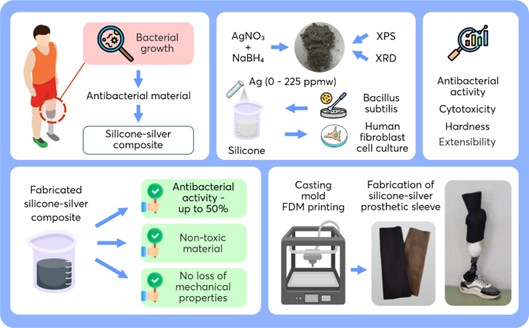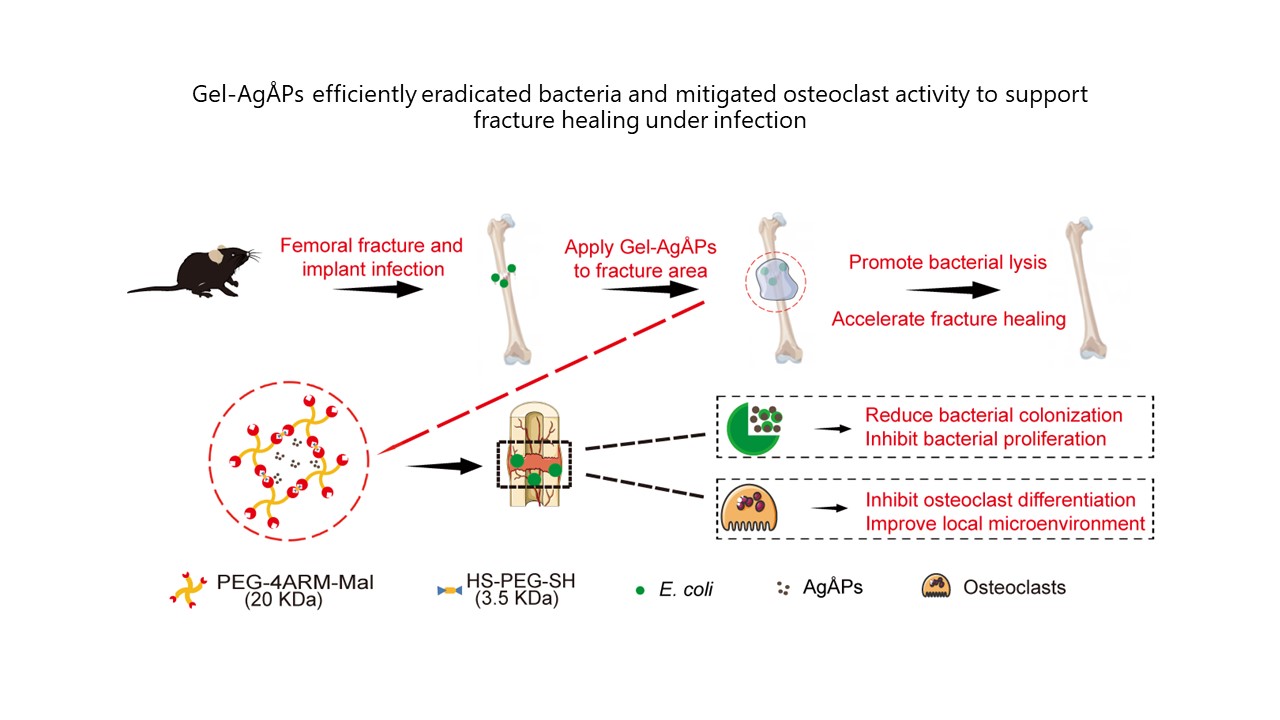ORIGINAL RESEARCH
doi:https://doi.org/10.12336/bmt.24.00073
The threat of bacterial growth on the skin under the prosthetic liners or sleeves is an important problem, which can cause various serious diseases up to the repeated amputation. One of the promising ways to solve this problem is to use antibacterial materials as a liner/ sleeve material. Among others composite based on the silicone polymer with silver particles additive is may be a simple and effective solution, since the silicone is the main material for the prosthetic liners and sleeves and silver demonstrates pronounced antibacterial effect. However, the questions related to the optimal concentration of silver in silicone that results in maximum antibacterial efficiency without harming human skin are still open. In the present work, synthesis of metallic silver powder from a mixture of micro- and nanoparticles was performed and composite samples based on silicone polymer with different silver concentrations were fabricated. The antibacterial properties of fabricated samples were studied using the microdilution method against gram-positive spore-forming bacteria Bacillus subtilis. The cytotoxic effect of the tested samples was evaluated on healthy human fibroblast cell (NAF1nor). Moreover, the effect of adding silver micro- and nanoparticles to silicone on its extensibility and hardness was studied. The results showed that the addition of silver has a noticeable effect on the antibacterial properties of silicone polymer reaching more than 50%. Furthermore, all tested silicone-silver composites were shown to be non-toxic. The presence of silver does not significantly affect the relative elongation of the samples. However, hardness increases with higher silver concentrations. In the final phase, prototypes of the silver-filled silicone prosthetic sleeve were fabricated for utilisation by the patient at the prosthetic-orthopaedic clinic. The testing of the prototype was successfully completed by the patient, thereby demonstrating practical functionality and suitability for clinical use.

COMMENTARY
2025, 6(1): 110–111. doi:https://doi.org/10.12336/biomatertransl.2025.01.010
COMMENTARY
2025, 6(1): 106–109. doi:https://doi.org/10.12336/biomatertransl.2025.01.009
COMMENTARY
2025, 6(1): 103–105. doi:https://doi.org/10.12336/biomatertransl.2025.01.008
RESEARCH ARTICLE
2025, 6(1): 85–102. doi:https://doi.org/10.12336/biomatertransl.2025.01.007
Orthopedic implant-associated infections pose a significant clinical challenge, often requiring surgical intervention along with systemic antibiotic treatments. To address this issue, we developed a novel approach using Ångstrom-scale silver particles (AgÅPs) with broad-spectrum antibacterial properties. Specifically, we formulated a polyethylene glycol hydrogel infused with AgÅPs (Gel-AgÅPs) designed for treating fracture fixation infections. This novel hydrogel formulation is injectable, ensuring precise adherence to both the exposed tissue and fracture surfaces, thereby allowing the direct targeted action of AgÅPs at the infection site. The Gel-AgÅPs significantly reduced the infection caused by Escherichia coli (a model pathogen of orthopedic implant infection) in a murine femoral fracture model. Moreover, the Gel-AgÅPs-treated infected fractures healed completely within 6 weeks, exhibiting bone formation and mechanical strength comparable to those of uninfected fractures. Further analysis revealed a significant downregulation of local inflammatory response as evidenced by a lower expression of inflammatory markers in Gel-AgÅPs-treated fractures compared to untreated infected controls. Furthermore, Gel-AgÅPs exhibited a unique ability to inhibit osteoclast differentiation, a critical factor in infection-induced bone degradation, without impacting osteoblast activity. In conclusion, Gel-AgÅPs exerted a dual therapeutic effect by eradicating bacterial infection and mitigating inflammation-induced osteoclast activity, thereby expediting infected fracture healing. This innovative approach is a promising therapeutic alternative to conventional antibiotic treatments, potentially transforming the treatment landscape for orthopedic implant-associated infections.

Catalytic Biomaterials for Disease Theranostics
Hydrogel Microspheres and Regenerative Medicine in Biomaterials Translational






